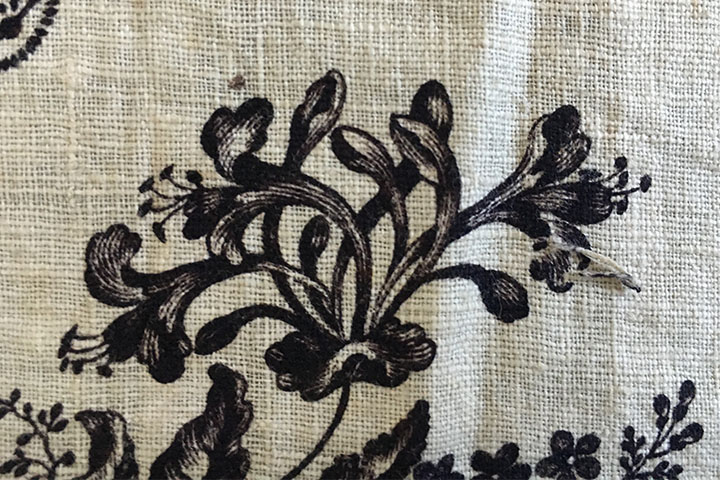




These extremely rare copperplate engraved pieces, have flower blooms and fruit on one stem, a good indication of English manufacture.They came from the top segment of a Dutch cape which was originally a skirt. The rest of the cape is black and white hand painted Indian chintz. A case of reusing lovely pieces of fabric in their later life.
I sold a gown this year with very similar design, also in same monochrome colouring. See English Dress - 18th century Sold section. I feel that these pieces were produced by the same manufacturer.
Of the gown I wrote: Philip Sykas kindly looked at photos of the print and commented:
The layout and treatment are typical of English copperplate engraving. But I don't think I could pin this down to a particular works. The place to look would be at Musée de l'Impression sur Etoffes (MISE) 382. I have a few images taken back in 2005. Talwin P9 [my 015] and P67 [my 088]; and Munns S80 [my119] and S191 [my144-2] have similarities. The album will hold many more images. Talwin & Foster and John Munns would be good candidates but that may be as far as one can go unless the MISE album holds the answer.
I contacted Jean Francois Keller, curator at the Musée de l'Impression sur Etoffes who kindly looked in their English pattern books of this date. We have a little book of English prints in our library with prints on paper and also some big prints on paper from Merton and Bromley and some are in the style of your dress. The fabric of the dress is definitively English. We have paper prints in the style and they are said to be made in England in Merton Abbey or in Bromley Hall around 1770-1775. M Keller kindly sent a photo of a print from one of their three English pattern books, which is quite similar (see last photo). We only have one with print similar to your dress. I looked all over the book twice and did not find your dress design and the 2 pictures I have sent are the closest to your dress. The company, which printed these, was Nixon & Co.
In 1752 Francis Nixon and Theophilus Thompson set up the Drumcondra Printworks in Dublin, Ireland, printing with copper plates. The business closed in 1757 and was bought by George Amyand, of Phippsbridge, Near Merton, Surrey who had established a printworks in 1752. Nixon joined him in 1757 and the company is listed in Mortimer’s London Directory of 1763 as Nixon and Amyand. Nixon died in 1765 and Amyand 1766 but the firm continued to operate as Nixon & Company until 1789 when it was sold.
The other printer who may have printed our gown fabric was Ollive and Talwin (1763-1783) of Bromley Hall printworks. The Bromley Hall factory on the right bank of the River Lea in East London was probably the largest of the early print works. It is first mentioned in the 1740s and was operated successively by members of the Ollive's, a Quaker family, who had been dyers and calico printers since the late 17th century.
The V &A’s Bromley Hall pattern book really has no similar designs, but some prints have similar star shaped flowers which can be found on p 112 **
The gown came from the costume hire company Bakkers of Amsterdam, started in the 1860s. Mr Bakker previously worked at the Royal court in the Hague where he bought out of date gowns from aristocratic ladies, who would have been wearing current designs. The company closed some 10 years ago. It was on the Oude Zijds Voorburgwaal in the centre of Amsterdam.
The copperplates for this gown were 18 1/2 in; 47 cm sq. The gown has been well made, unlike similar dated silk gowns. I assume this was because silk gowns were frequently unpicked, cleaned and re-made, due to the expense of the silk. Gowns of printed cotton or linen were more wearable for everyday tasks and needed to be better made and last longer. Few exist because they would have been handed down to servants when they were out of fashion, reduced to caracaos or petticoats and gradually worn out.
These pieces are of natural linen cotton mix? copperplate printed in dark brown. The vertical linear design with six different ribbon stripes (one on extreme left hardly there) with a variety of trellis, dot and minute flower fillings, with small sprays of elegant flowers and fruit including hops, rose bud and roses, honeysuckle, lillies, pink (carnation) and other flowers, between straight stripes with ribbon fillings and sprays of the same six petalled flowers.
Fabric width 35 1/2 in; 90 cm
All pieces 7 in; 18 cm drop
Top pieces 13 1/2 in;35 cm and 29 in; 74 cm wide
Lower pieces 51 in; 1.3 m.
Basically very good and strong. All pieces have slight grubbiness in areas and some marks. The lower left piece has two rust coloured marks and a hole. The lower right hand piece has a small rust type mark.
**Bromley Hall Pattern Book. V & A Prints & Drawings department. E458 (18) p 112.
English Chintz . English Printed fabrics from their origins until present day. by Peter Floud Exhibition at V & A May - July 1960.
Printed Textiles at Winterthur Museum. Linda Eaton.
Antiques 1957. USA magazine with 8 articles by Peter Floud and Barbara Morris on copper plate print designs. There is nothing similar, on such a small scale, as our gown print.
All images and text © meg-andrews.com 2021